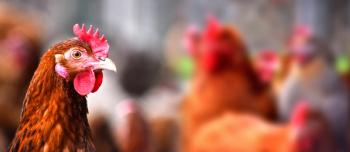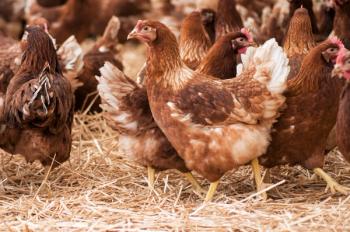
Abdominal discomfort in llamas and alpacas: causes and clinical characteristics (Proceedings)
The subject of abdominal pain in camelids has been addressed a number of times over the years, with the discussion becoming progressively more detailed as we gain experience with these species. We were truly learning from scratch, as the South American approach (hands off and deal with the consequences) was generally unsuitable to North American tastes.
The subject of abdominal pain in camelids has been addressed a number of times over the years, with the discussion becoming progressively more detailed as we gain experience with these species. We were truly learning from scratch, as the South American approach (hands off and deal with the consequences) was generally unsuitable to North American tastes. The tone has varied over the years, from extremes such as "we had better cut it, because it's worth so much," to, "why cut it, because they all die." The bases for these extreme views were the high proportion of underlying lesions that were a major morphologic defect, such as a ruptured ulcer, and they general uncertainty on how to proper assess the likely severity and nature of the disease in a sick camelid. As we have become more knowledgeable about disease states and more proficient and comfortable in dealing with them, we have improved in both those regards.
CAUSES OF COLIC
Camelids develop abdominal pain for the same reasons as other animals. The major mechanisms are activation of stretch-pain receptors in the mesentery, various ligaments, or organ capsules, muscle spasms, inflammation, and ischemia. Similar to cattle, the capacity and location of the gastric compartments combined with the ability to regurgitate excess fluid decrease the likelihood of gastric distention or is tug on the mesentery contributing to pain signs. Additionally, relatively complete forestomach fermentation in adult camelids decreases the likelihood of aberrant intestinal fermentation, and hence gas colics are uncommon. However, aberrant fermentation can occur in younger camelids, or adults with depletion of their normal gastric microbial population. In crias, this "milk colic" may be severe, but usually only lasts a few hours. As in other species, poorly digestible milk replacers or viral damage to the intestinal brush border may contribute to aberrant fermentation. In adults, it is downright rare. In all ages, infection by gas-producing bacteria may contribute to signs with some forms of enteritis.
Capsular stretch is a more important source of pain when it involves non-digestive abdominal organs. Colic signs may be severe with distention of the kidney, ureters, or to a lesser degree, bladder. Milder signs are evident with enlargement of the liver due to lipidosis, hepatitis, or fluke infection.
Anatomically, the camelid stomach and intestines bear more similarity to cattle than horses. Aside from thrombosis due to systemic events, ischemia is most likely in regions with long mesenteric attachments and relative mobility. In camelids, this includes the distal phlange of the small intestine and the whole of the ascending colon, including its spiral loop. Rotation or displacement of the third compartment have not been described. Described ischemic events occur as a results of strangulation involving the epiploic foramen (rare), body wall defects (intermediate frequency), diaphragmatic defects (rare), mesenteric defects (rare), rotation around the mesenteric root (most common), intraabdominal adhesions (intermediate), or intussusception (rare). Non-strangulating entrapments can occur with less severe involvement of most of these structures as well. Intussusception has been described involving the jejunum, cecum, or ascending colon. Uterine torsion is among the more common causes of colic. Liver lobe or splenic torsion is extremely rare. Risk factors for entrapments obviously include the presences of body wall, mesenteric, or diaphragmatic defects. Enteritis or coccidial infection may promote mesenteric volvulus or intussusception, particularly when they involve the colon.
Intraluminal obstruction is usually caused by hair or plant fiber balls. In most cases, these appear to form in the gastric compartment, where multiple may be found. Some, smaller balls may form in the proximal loop of the ascending colon. Hairballs are most common in animals less than one year old. Ectoparasites, boredom, and post-weaning suckling behavior are thought to be risk factors. Phytobezoars may develop in animals with poor chewing or on excessively fibrous feed. Long-stem spring pasture appears to increase risk in the Pacific Northwest. Obstruction tends to occur near the pylorus or in the beginning of the duodenum in alpacas and smaller llamas, and in the centrifugal loops of the spiral colon in adult llamas. With time, bezoars lodged in the duodenum may migrate further along the intestine, but it is rare for them to make it into the colon or pass entirely. Tapeworm impaction with ulceration throughout the jejunum has been described in one alpaca. Foreign body obstruction is very rare.
Over recent years, a number of important causes of non-surgical colic have been identified. The earliest work on this identified that many camelids with colic signs that abated with time or medical treatment had serum biochemical abnormalities that reflected either obstruction (hypochloremic metabolic alkalosis) or enteritis (hyponatremia, hypochloremia, and often hypoalbuminemia). Our subsequent experiences suggest that "obstruction-like" episodes are rare. Small bezoars may pass, but that is uncommon and may result in mucosal abrasion. Hypochloremic metabolic alkalosis appears uncommon with ileus in sick camelids, which generally trend toward hyperchloremia. Whether ruptured ulcers with omental bursitis can cause this biochemical abnormality is unclear.
Camelids with "enteritis-like" blood work and colic signs may have a variety of conditions. The single most common in many different geographic areas appears to be Eimeria macusaniensis infection. These large coccidia invade the gut epithelium and lamina propia, in contrast to most GI parasites, which remain in the epithelium. It is possible that this deeper invasion has a more profound effect on GI motility or is simply more inflammatory, and hence more likely to cause colic. Other clinical evidence, including gut fluid distention and ileus detected ultrasonographically, by succussion, or at surgery, suggest that pooling of intraluminal fluid resulting in mesenteric tug is the main contributor to colic signs. This ileus can confound diagnosis, because it inhibits or delays the onset of diarrhea. Supportive evidence for a diagnosis of Eimeria macusaniensis infection includes hypoalbuminemia disproportionately severe for the level of anemia, occasionally hyponatremia, and identification of oocysts on fecal examination, if the infection has achieved patency.
Other common causes of enteritis without severe inflammation include coronavirus and rotavirus, Giardia, Trichuris, and Cryptosporidia. Salmonellosis is fairly uncommonly reported in camelids, and may or may not cause severe inflammation. Other bacterial enteritides include Clostridium perfringens and occasionally coliform organisms or Bacteroides-like organisms. In North America, the bacterial enteritides, except for Salmonellosis, are rarely considered primary diseases, and usually occur secondary to parasitic or viral infections, physical or chemical damage to the epithelium, or gut thrombosis. The less inflammatory enteritides are rarely associated with colic, and it usually resolves rapidly with the onset of diarrhea. Affected camelids may have hyponatremia and hypochloremia, relatively specific indicators of intestinal diseases in camelids, and hypoalbuminemia. Acidosis is generally less common or milder than with comparable disorders in cattle. Camelids with bacterial enteritis may additionally have fever, tachycardia, abnormal mucus membranes, high liver enzymes, lactic acidosis, and an abnormal leukogram. All abnormalities need not be present simultaneously to support this diagnosis. Diarrhea tends to be scant and less aqueous with bacterial enteritis or Eimeria macusaniensis infection, as opposed to profuse and watery with viral or other parasitic enteritides.
Camelids with colic due to bacterial enteritis or Eimeria macusaniensis infection can be very difficult to differentiate from camelids with gut strangulations, entrapments, or intraluminal obstructions, especially if the surgical lesion has been allowed to progress. Both types of disorder result in a camelid with low fecal output and also in declining systemic condition. For this reason, combined with a historical lack of rapid identification of surgical lesions, and the reluctance to watch hospital patients deteriorate without trying every possible treatment modality, many camelids with inflammatory conditions in the abdomen were surgically explored in the past. Exploration is helpful in confirming the lesion and establishing the prognosis in camelids with inflammatory diseases, and gives the opportunity to obtain biopsy specimens, which is especially helpful in diagnosing prepatent Eimeria macusaniensis infection, but is unlikely to lead to clinical improvement.
Slaframine poisoning is an uncommon, but important cause of non-surgical colic. It presumably has the same pathogenesis as in other species, and is associated with ingestion of the indolizidine alkaloid produced by fungus Rhizoctonia leguminicola. This fungus colonizes legumes, particularly red clover in damp areas and subterranean clover in dry areas, causing discoloration of the clover known as 'black patch'. Camelid exposure appears to be most common in the damp seasons, particularly Spring and Fall, which is conducive to both the clover and the fungus. Multiple animals may be affected simultaneously, which is uncommon with all other causes of colic. Signs occur within hours of ingestion in other species. In camelids, they last from 1 to 3 days, usually with a steady clinical improvement after the first 24 hours. In addition to colic, affected camelids may have profuse salivation ('Slobbers'), other SLUD signs, tremors, and a stiff gait. Treatment is not usually necessary, and the specific combination of signs, especially if multiple animals are affected or the discolored clover can be found, helps give the attending veterinarian confidence of the diagnosis. Clinical pathologic abnormalities have not been reported.
CLINICAL SIGNS AND PHYSICAL EXAMINATION
To the practitioner most acquainted with colic in equids, tachycardia, abdominal distension, absence of appetite, borborygmal sounds, and fecal passage as well as activities including pawing, restlessness, and stretching the abdomen are frequently taken as signs of colic. Although all of these signs may be present in some colicky camelids, most have neither tachycardia nor active signs of pain. Camelids have been described as being stoic animals that try to hide signs of illness and pain. While it is true that signs in camelids are less visible and violent than in horses, their behavior is restive and abnormal enough to be apparent to the careful observer. Specific signs of colic include lying in an abnormal position: sternal recumbency with one or more legs extended to the side or lateral recumbency; repeatedly getting up and lying down; kicking at the abdomen; and frequently changing position while recumbent. Lying quietly in sternal or lateral recumbency is not specific for colic.
Level of pain and presence or absence of other signs can be used to estimate the likelihood of the various categories of lesions. Small intestinal obstruction often leads to more subtle signs than other types of lesions, because fluid is refluxed into the gastric compartments and inflammation is minimal. This is most true for obstructions near the pylorus; the further into the jejunum the bezoar is pushed, the more tension there is on the mesentery and the more painful the camelid appears. Thus, in addition to the importance of recognizing pain signs, it is important to remember that camelids with mild to subtle signs still may have life-threatening obstructive lesions.
Very cranial obstructions can cause several other abnormalities that help differentiate them from other lesions. Fluid accumulation in the forestomach leads to bilateral, ventral abdominal distension, and a pot-bellied appearance. Gas may be eructated until the gastric fluid level reaches the cardiac sphincter, causing muscular spasms. After that time, bloat may be noticed. Other signs include dehydration, depression, and in rare cases, vomiting. Abdominal distension is difficult to assess in full-fleeced camelids; direct external palpation ("bear-hug") may be necessary. Other conditions, including advanced pregnancy, effusive peritonitis, venous congestion (as with strangulation), and enteritis can lead to abdominal distension without gastric engorgement. These conditions may be distinguished by other characteristics. It is also appropriate to mention here that subjective assessment of cranial abdominal pain by palpation of the flanks is extremely difficult to interpret; most camelids do not like being touched in that area and it is natural for them to flinch, jump, or lie down.
Dehydration and depression with small intestinal obstruction are due to sequestration of ingested and secreted fluids, with minimal functional intestinal absorptive surface area. Signs worsen with proximity to the pylorus, completeness of the obstruction, and time. Thus, a camelid with duodenal phytobezoar obstruction is likely to have subtle colic signs that abate after a few days due to progressive dehydration and depression. In contrast, a camelid with a colonic bezoar obstruction that leaves most of its intestinal absorptive epithelium functional is likely to have more obvious pain signs and develop minimal dehydration.
Camelids with strangulating obstructions or sepsis also develop signs of dehydration and depression (and also distension, as previously mentioned) due to venous pooling, peritoneal effusion, and the inflammatory response. Such camelids usually appear more painful and differ in other aspects of the diagnostic evaluation, but may be extremely difficult to differentiate from camelids with jejunal obstruction or any small intestinal obstruction with inflammatory complications.
In addition to the more obvious colic signs and possible dehydration and depression, camelids with inflammatory or cecocolic diseases may also show tenesmus. Camelids usually defecate and urinate at a communal dung pile several times a day, but rarely spend more than a minute or two at the pile or assume the posture when away from the pile. Tenesmus with obstruction is usually non-productive, whereas camelids with enteritis or peritonitis may have diarrhea. Thus, tenesmus with diarrhea and colic signs suggests a severe inflammatory condition. Tenesmus is also a common sign with urogenital disorders.
Anorexia, lack of feces, and gastric hypomotility are common findings in camelids with gastrointestinal disease, but lack specificity because they are also seen with diseases of other organ systems. However, finding appetence, normal fecal passage, and normal ruminations in a camelid with colic strongly supports a mild, transient problem, a non-inflammatory, non-gastrointestinal condition (i.e. uterine torsion), or the early stages of more severe disease. These signs should be monitored for resolution or progression.
Fecal passage may provide other insights into the nature of the disease. Camelids with obstructions may pass normal feces for 1 to 3 days (longer with small intestinal than cecocolic obstruction), but eventually change to dry, mucus-covered feces, and later stop defecating altogether: camelids with entrapments may continue to pass small quantities of normal or blood-tinged feces, whereas camelids with strangulations and necrotic enteritis and peritonitis may pass diarrhea in decreasing quantities. Consistent passage of small amounts of diarrhea in spite of ongoing pain signs for up to 4 days is common with E. macusaniensis infection. Continued, profuse diarrhea or normal feces are rare in camelids with colic due to gastrointestinal lesions requiring surgical repair.
Vital signs have been of little value in determining severity of colic and the presence of surgical lesions. Camelids with all types of lesions have been recorded as having low, normal, and high pulse and respiratory rates. It is our general bias that the more normal the vital signs, the better the prognosis, but this is not always true. High rectal temperatures are most common with peritonitis, but are not specific to the cause of inflammation. Low rectal temperatures can occur with most disorders and are usually a sign of circulatory compromise and more severe disease. When interpreting heart rate, it is imperative to remember that most healthy adult camelids have heart rates of 72 beats/minute or less, and that values between 72 and the published high end of 90 beats/minute may reflect pain or shock.
FREQUENCY OF COLIC
The types of lesions described here have been blamed for up to 19% of camelid deaths in camelids. It is possible that the percentages are even higher because colic signs may not have been recognized in all camelids, even if they were present. In our practice, colic is responsible for approximately 5% of camelid admissions. The percentage is likely to be lower in general practice, though poor recognition of signs may lead to underdiagnosis. The prevalence of individual diseases is likely to vary based on geographic, dietary, breed prevalence, and other factors. With many of these diseases, colic signs are transient, subtle, and may not be noticed without careful, constant observation.
REFERENCES LISTED AFTER FOLLOWING ARTICLE
Newsletter
From exam room tips to practice management insights, get trusted veterinary news delivered straight to your inbox—subscribe to dvm360.




